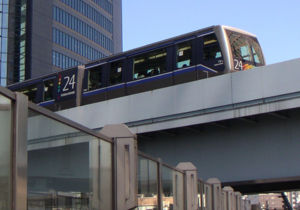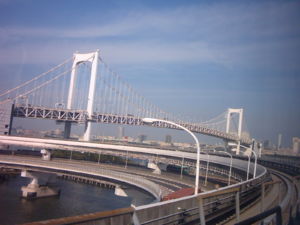Yurikamome
New Transit Yurikamome (新交通ゆりかもめ Shinkōtsū Yurikamome?), formally the Tokyo Waterfront New Transit Waterfront Line (東京臨海新交通臨海線 Tōkyō Rinkai Shinkōtsū Rinkai-sen?) is an automated guideway transit service operated by the Tokyo Waterfront New Transit Corporation, connecting Shinbashi to Toyosu, passing through the artificial island of Odaiba in Tokyo, Japan, a market in which it competes with the cheaper but less glamorous Tokyo Waterfront Railway (Rinkai Line).
The line is named after the Black-headed Gull (yurikamome in Japanese), a common denizen of Tokyo Bay and the official prefectural bird.
Technology
Yurikamome is Tokyo's first fully automated transit system, controlled entirely by computers with no drivers on board. However, the line is not the first in Japan, as Kobe's Port Liner, opened in 1981, 14 years before the Yurikamome.
Yurikamome is often incorrectly called a monorail, due to the resemblance of the elevated concrete track, but the track is actually just a funnel and the trains are supported by two rows of rubber wheels. The rail in the centre of the track serves only to guide the train, not support it, so it does not qualify as a monorail.
History
Before its 1995 opening, it was widely feared that the Yurikamome would end up as a multibillion-yen boondoggle. The artificial island of Odaiba, which it serves, had been designed and constructed at prodigious expense before Japan's economic crash and, much like London's equally beleaguered Canary Wharf, there simply didn't seem to be enough demand to support it. The first few months of operation provided a slight sigh of relief, as ridership hovered around 27,000 passengers per day, only a little less than the predicted 29,000, but still far, far less than the 80,000 passengers needed to be profitable.
However, in 1996 the Tokyo Metropolitan Government re-zoned Odaiba from pure business and residential to also permit entertainment zones. Tokyo may be next to the sea on the map, but before Odaiba, effectively the entire coastline had been taken over by an endless concrete strip of ports and warehouses. Promoted as the "Rainbow Town", the island provided Tokyo with a strip of liveable seaside, and it became an instant hit. Within one year, ridership doubled to 60,000, and as more and more of the restaurants, shopping malls, exhibition centers and museums opened, the traffic kept growing and growing. On May 4, 1997, during Golden Week, the system was completely maxed out when 130,000 people tried to board in a single day.
And it wasn't just the island that they were going to, the Yurikamome had become an attraction in itself. To hoist itself from sea level to the Rainbow Bridge, the Yurikamome does a rather spectacular 270-degree loop, providing panoramic views of both mainland Tokyo and Odaiba. Easily accessible and comfortable despite its technological prowess, most islandgoers continue to opt for the Yurikamome despite its high price, with the fares of 180 to 370 yen being nearly twice that of a normal subway.
- November 1, 1995: Shinbashi-Ariake opens, using temporary Shinbashi station
- March 22, 2001: Current Shinbashi station opens, temporary station closed
- November 2, 2002: Shiodome Station opens
- March 27, 2006: Ariake-Toyosu opens; all stations adopt letter/number identification based on Tokyo Metro.
An accident on the Yurikamome occurred on the afternoon of April 14, 2006. According to a government commission, one of the axles on the six-car train was cracked due to metal fatigue, causing a rubber tire on the train to fall off.[1] The train came to a halt near Fune-no-Kagakukan station, and services were suspended on the entire line. This came at the start of a busy weekend when events were taking place at Tokyo Big Sight on Odaiba, but, according to news reports, alternate means of transportation were offered and there was no major confusion. The Yurikamome resumed limited train service on April 17 while further inspections and tests continued, with full service restored on April 19.
Future
The Yurikamome's future looks bright: at over 100,000 passengers per day, the Yurikamome is making a net profit and will pay off its loans in full faster than the 20 years originally anticipated. Operating frequency, hours of operation and number of trainsets have been continually revised upwards to accommodate for the ever-increasing number of passengers.
No further extensions are currently planned.
Stations
- Shimbashi Station (U-01)
- Shiodome Station (U-02)
- Takeshiba Station (U-03)
- Hinode Station (U-04)
- Shibaura Futo Station (U-05)
- Odaiba Kaihin Koen Station (U-06)
- Daiba Station (U-07)
- Fune no Kakagu-kan Station (U-08)
- Telecom Center Station (U-09)
- Aomi Station (U-10)
- Kokusai Tenjijo Seimon Station (U-11)
- Ariake Station (U-12)
- Ariake Tennis no Mori Station (U-13)
- Shijo-mae Station (U-14)
- Shin-Toyosu Station (U-15)
- Toyosu Station (U-16)
Yurikamome trains are taken in and out of service at Ariake, and are stored in a yard near Tokyo Big Sight when out of service.
See also
References
- ↑ "2ND LD: Yurikamome wheel fell off as result of metal fatigue: gov't", Kyodo News (reprinted by Yahoo! News Asia), 2006-04-17. Retrieved on 2008-02-01.
External links
Mass transit in Tokyo | |
|---|---|
| Metro lines (Subway) | Chiyoda · Fukutoshin · Ginza · Hanzōmon · Hibiya · Marunouchi · Namboku · Tōzai · Yūrakuchō |
| Toei lines | Subway: Asakusa · Mita · Ōedo · Shinjuku Streetcar: Arakawa |
| JR lines | Yamanote · Chūō · Chūō-Sōbu · Jōban · Keihin-Tōhoku · Keiyō · Saikyō · Shōnan-Shinjuku · Sōbu · Tōkaidō · Yokosuka |
| Other networks | Keikyū · Keiō · Keisei · Nippori-Toneri · Odakyū · Seibu · Tōbu · Tokyo Monorail · Tōkyū · TWR · TX · Yurikamome |
| Around Tokyo | Chiba Monorail · Enoden · Hokusō · Saitama Rapid · Saitama New Urban · Shin-Keisei · Shōnan Monorail · Sōtetsu · Tama Monorail · Tōyō Rapid · Yokohama MM · Yokohama Subway |
| Terminals | Asakusa · Ikebukuro · Kita-Senju · Oshiage · Shibuya · Shinagawa · Shinjuku · Tōkyō · Ueno |
| Miscellaneous | PASMO · Passnet · Suica · Transportation in Greater Tokyo |


